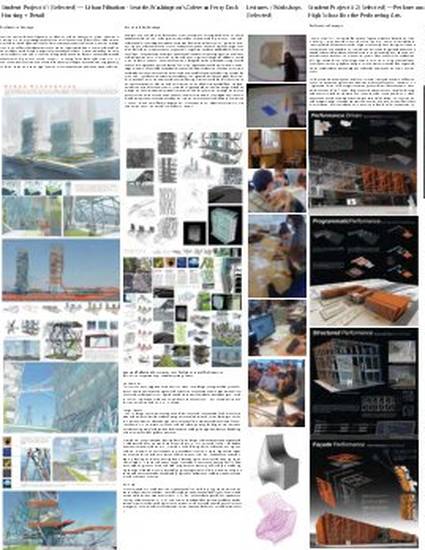
Presentation
2010_NCARB Prize Design Collaboratory
NCARB
(2010)
Abstract
Design Collaboratory [2010 NCARB Prize Winner]
Since the 2007/2008 academic year, this interdisciplinary design studio called the Design Collaboratory has been co taught by four faculty members building upon the successful 46-year multi-disciplinary experience of this academic institution cultivating innovative models of practice through an integrated architecture and architectural engineering design studio. This team of professors, with over 40 years of collective cross disciplinary collaborative experience, and students from Architecture and Architectural Engineering Departments participate in a 20-week design studio.
The Design Collaboratory provides for an intensive two-quarter course sequence designed to familiarize undergraduate students with practiced based knowledge and application for how interdisciplinary teams can work together to design buildings. All discipline students have a seat at the building design table and therefore students learn the fundamental principles for negotiation and building systems integration. Students are provided a unique opportunity, not provided anywhere else in the curriculum, where they are all fully engaged in the studio design project that is enhanced by the support and collaboration with leading practitioners in the fi eld.
This interdisciplinary team approach to building design has all disciplines involved from the inception of the building design project. Innovative uses of steel, integration of structure and design, and energy efficient cladding systems, are emphasized in this comprehensive design studio. The DC’s collaborative practitioner partners are internationally recognized architecture and engineering fi rms, and the educational division of a major software company. Interdisciplinary student teams address complex structural/cladding systems, environmental issues, and use advanced digital technology tools, while simulating innovative collaborative practice strategies based on workflows demonstrated by leading design and engineering firms.
This Collaboratory model expands the role of the practitioner in the academic design studio by having leading
firms sponsor workshops, lectures and critiques across the disciplines to reformulate the methodology for integrating a practitioner’s workfl ow strategies into a studio project.
The five major Collaboratory activities are:
1. Practitioner Lectures/Workshops
2. Practitioner Reviews and Discussions in a Selected Practitioner’s Offi ce
3. Advanced Technology Training By Software Company and Practitioners
4. Digital and Physical Prototyping of Project Cladding System
Design Collaboratory Project Goals —
• To challenge or transform the preconceptions about the boundaries between academia and practice;
• For fi rms to strengthen students’ preparedness for practice;
• To provide opportunities for practitioners to teach, mentor and recruit;
• For students to learn from and in a practice environment.
Keywords
- Design Collaboratory,
- Interdisciplinary Collaboration
Disciplines
Publication Date
2010
Citation Information
Thomas Fowler, Kevin Dong, James Doerfler and Mark Cabrinha. "2010_NCARB Prize Design Collaboratory" NCARB (2010) Available at: http://works.bepress.com/tfowler/38/
Creative Commons License

This work is licensed under a Creative Commons CC_BY International License.
